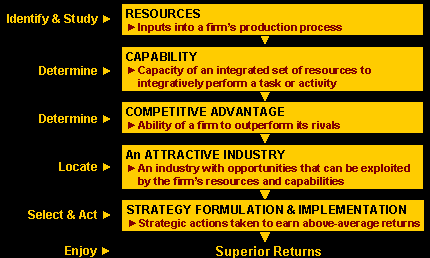|
New
Paradigm: Resource-Based Theory
The currently dominant view of business strategy -
resource-based theory - is based on the concept of
economic rent and the view of the company as a collection
of capabilities. This view of strategy has a coherence and
integrative role that places it well ahead of other
mechanisms of strategic decision making.
Traditional strategy models, such as Michael Porter's five
forces model, focus on the company's external competitive
environment. Most of them do not attempt to look inside
the company. In contrast, the resource-based perspective
highlights the need for a fit between the external market
context in which a company operates and its internal
capabilities.

In contrast to the Input / Output Model (I/O model), the
resource-based view is grounded in the perspective that a
firm's internal environment, in terms of its resources and
capabilities, is more critical to the determination of
strategic action than is the external environment.
"Instead of focusing on the accumulation of resources
necessary to implement the strategy dictated by conditions
and constraints in the external environment (I/O model),
the resource-based view suggests that a firm's unique
resources and capabilities provide the basis for a
strategy. The strategy chosen should allow the firm to
best exploit its core competencies relative to
opportunities in the external environment".
Sustainable
Competitive Advantage
According to this view, a company's competitive advantage
derives from its ability to assemble and exploit an
appropriate combination of resources. Sustainable
competitive advantage is achieved by continuously
developing existing and creating new resources and
capabilities in response to rapidly changing market
conditions.
Creating
Economic Rent
The resource based view of strategy emphasizes economic
rent creation through distinctive capabilities. Economic
rent is what companies earn over and above the cost of
the capital employed in their business. It is the measure
of the competitive advantage, and competitive advantage is
the only means by which companies in competitive markets
can earn economic rent. The objective of a company is to
increase its economic rent, rather than its profit as
such. "A company which increases its profits but not its
economic rent - as through investments or acquisitions
which yield less than the cost of capital - destroys
value".4 The perspective of economic rent forces the
question 'why can't competitors do that?' into discussion.
Resources and
Capabilities
Each organization is a collection of unique resources and
capabilities that provides the basis for its strategy and
the primary source of its returns. In the 21st-century
hyper-competitive landscape, a firm is a collection of
evolving capabilities that is managed dynamically in
pursuit of above-average returns4. Thus, differences in
firm's performances across time are driven primarily by
their unique resources and capabilities rather than by an
industry's structural characteristics.
Resources are
inputs into a firm's production process, such as capital,
equipment, the skills of individual employees, patents,
finance, and talented managers. Resources are either
tangible or intangible in nature. With increasing
effectiveness, the set of resources available to the firm
tends to become larger.5 Individual resources may not
yield to a competitive advantage. It is through the
synergistic combination and integration of sets of
resources that competitive advantages are formed.
A capability
is the capacity for a set of resources to integratively
perform a stretch task or an activity. Through continued
use, capabilities become stronger and more difficult for
competitors to understand and imitate. As a source of
competitive advantage, a capability "should be neither so
simple that it is highly imitable, nor so complex that it
defies internal steering and control."

|
![]()